Background
Wildfires in the Western United States — and around the world — are growing larger and more destructive due to increased temperatures and drier conditions. In many regions, fire season is lengthening, and extreme weather conditions are fueling more frequent, intense, and wide-spread wildfires. According to US Forest Service research, the Western United States, Mexico, Brazil, and East Africa now have fire seasons that are more than a month longer than they were 35 years ago.
Wildfires pose a serious threat not only to human and animal life, health, and welfare but also to local economies and the private sector. Recent years have also highlighted the risks companies and utilities face in their operations, reputation, and bottom lines in the United States. For instance, investor-owned utility PG&E agreed in 2022 to $55 million in settlements to avoid criminal prosecution, after its power grid sparked the 2021 Dixie Fire and the 2019 Kincade Fire.
Wildfires are also becoming an increasingly significant source of carbon emissions. According to NASA, emissions from forest fires have increased by 60% globally between 2001 and 2023, with a three-fold increase in North America and Eurasia. The 2023 Canadian fires alone are estimated to have released 640 million metric tons of carbon.
About the Partnership
In response to these growing risks posed by wildfires, one clear solution has emerged: removing decades of built-up fuel from forests – such as overgrown brush and dead trees – that contribute to larger, more destructive fires. While surveys show that most local residents support forest thinning and prescribed burns as tools to mitigate wildfire risk, these practices have historically faced strong opposition from small but vocal groups. To overcome this challenge, the US Forest Service has partnered with Forest Trends’ communications team to craft strategic, fact-based, data-driven messaging; conduct targeted outreach; and convene diverse coalitions to build a shared understanding of assets at risk, identify areas of mutual interest, and develop innovative partnership investment strategies.
Forest Trends and the Forest Service have more than 20 years of experience working together to advance innovation in forestry and conservation finance globally. Our decades-long partnership has explored a wide range of cutting-edge ideas through leadership seminars, joint research, and on-the-ground demonstrations — from forest certification and payments for ecosystem services to community forestry. Together, we’ve helped drive long-term change by building coalitions and fostering the systemic conditions needed for sustained investment in forest health.
Priority Landscape: Colorado’s Front Range
Catastrophic wildfires profoundly threaten Colorado’s quality of life, economy, and future opportunities and the state’s leadership is rising to the task. Colorado has a history of innovation to build on in meeting these challenges, including the pioneering “Forests to Faucets” partnership between Denver Water, the USDA Forest Service, the Colorado Forest Service, and the USDA Natural Resources Conservation Service. Colorado is also home to a forward-looking Coalition for Mass Timber, and innovative pilots in Steamboat Springs utilizing mass timber for workforce housing. Denver has some of the most progressive mass timber building codes in the country.
The State has also mapped out an ambitious set of strategies to address its wildfire crisis including the USDA Forest Service’s Wildfire Crisis Strategy, the Colorado Strategic Wildfire Action Program (COSWAP), and the Wildfire Ready Watersheds Program. All of these programs focus on increasing the scale and speed of forest heath treatments, including prescribed burns and the removal of excess fuels such as dead trees and brush and focus on the highest risk areas like the Front Range.
Project Goals and Impact
- Strategic outreach to build clear social license within the business sector and local communities to increase support for necessary forest health treatments. Forest Trends, together with the strategic communications firm Statler-Nagle, will support the Forest Service by building a comprehensive national strategy to better educate and engage the public on the wildfire crisis.
- Expand communications efforts—initially focused on the Front Range—to engage the public on forests and wildfire. Commitments from the Colorado Forum and the Denver Museum of Nature and Science will help clarify specific goals and partnership structures for prospective partners and collaborators.
- Work toward building an effective coalition grounded in a clear, long-term vision. Our team will define a roadmap with key milestones and explore the forms of partnership most needed — whether financial or political support, collaboration on communications, or engaging companies’ employees and customers.
Many of these interventions would also have broader national implications. And – crucially – what works on the Front Range can and should be replicated in other landscapes grappling with the national wildfire crisis.

